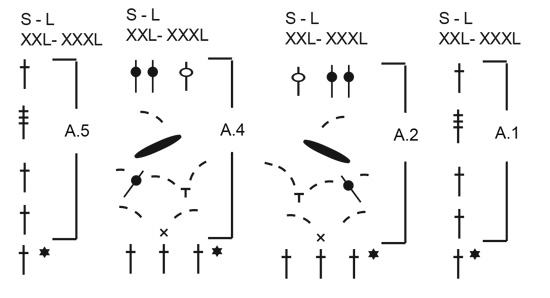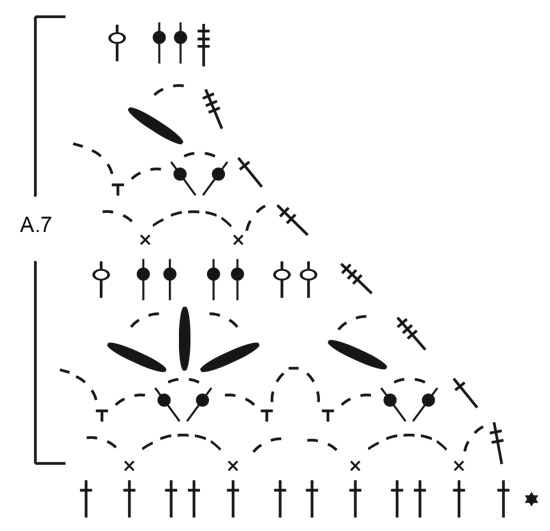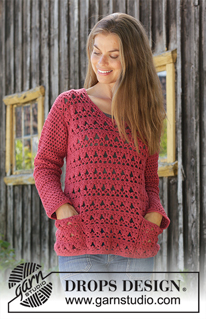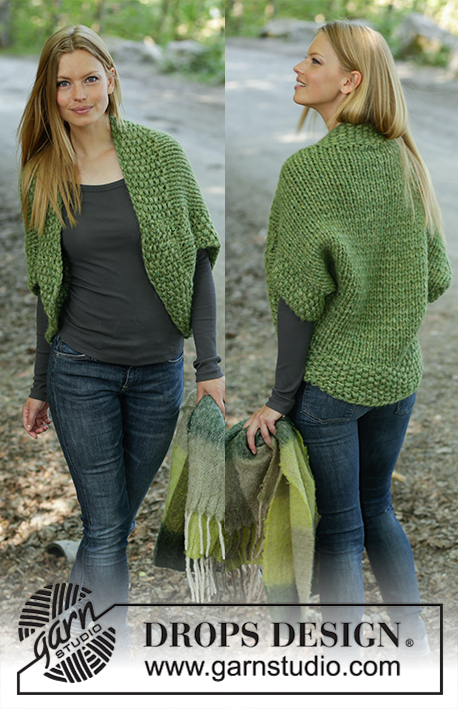Last Harvest |
|||||||||||||||||||||||||||||||
 |
 |
||||||||||||||||||||||||||||||
Crocheted jumper in DROPS Merino Extra Fine. The piece is worked with lace pattern, fans and pockets. Sizes S - XXXL
DROPS 196-24 |
|||||||||||||||||||||||||||||||
|
------------------------------------------------------- EXPLANATIONS FOR THE PATTERN: ------------------------------------------------------- PATTERN: See diagrams A.1 to A.10. Choose diagram for your size. CROCHET INFORMATION: At the beginning of each row of double crochets, replace the first double crochet with 1 chain stitch. At the beginning of each row of treble crochets, replace the first treble crochet with 3 chain stitches. At the beginning of each row of double treble crochets, replace the first double treble crochet with 4 chain stitches. At the beginning of each row of triple treble crochets, replace the first triple treble crochet with 5 chain stitches. ------------------------------------------------------- START THE PIECE HERE: ------------------------------------------------------- JUMPER - SHORT OVERVIEW OF THE PIECE: The piece is worked back and forth. Back and front pieces are worked separately, then you work the sleeves and pockets. All parts are sewn together to finish. An edge is worked around the neck. BACK PIECE: Work 94-101-108-122-129-143 chain stitches with hook size 4.5 mm and Merino Extra Fine. Work 1 treble crochet in the 4th chain stitch from the hook (= 2 treble crochets), 1 treble crochet in each of the next 6 chain stitches, * skip 1 chain stitch, 1 treble crochet in each of the next 6 chain stitches *, work from *-* to end of row = 80-86-92-104-110-122 treble crochets. Then work as follows from the right side: SIZES M-XL: Work A.1 (= 1 stitch) - read CROCHET INFORMATION above, A.3 (= 6 stitches) a total of 14-17 times in width and finish with A.5 over the last treble crochet. Continue this pattern onwards. REMEMBER THE CROCHET TENSION! A.1/A.3/A.5 are repeated in height. When the piece measures approx. 37-39 cm – adjust so that the last row worked is a row of treble crochets, work the armholes as follows: Cut the strand, skip 6-12 stitches (= armhole), work 1 slip stitch in next treble crochet, 3 chain stitches (= 1 treble crochet), A.3 (= 6 stitches) a total of 12-13 times in width and finish with A.5 over the next stitch (there are 6-12 stitches left on row for armhole). You have now worked the middle 74-80 stitches on the row. On the next row work A.1 in the last stitch. Continue this pattern. SIZES S-L-XXL-XXXL: Work A.1 (= 1 stitches) - read CROCHET INFORMATION above, A.2 (= 3 stitches), A.3 (= 6 stitches) a total of 12-14-17-19 times in width, A.4 (= 3 stitches) and finish with A.5 over the last treble crochet. Continue this pattern onwards. REMEMBER THE CROCHET TENSION! A.1 to A.5 are repeated in height. When the piece measures approx. 36-38-40-41 cm – adjust so that the last row worked is a row of treble crochets, work the armholes as follows: Cut the strand, skip 6-6-12-12 stitches (= armhole), work 1 slip stitch in next treble crochet, 3 chain stitches (= 1 treble crochet), A.2 (= 3 stitches), A.3 (= 6 stitches) a total of 10-12-13-15 times in width, A.4 (= 3 stitches) and finish with A.5 over the next stitch (there are 6-6-12-12 stitches left on row for armhole) You have now worked the middle 68-80-86-98 stitches on the row. On the next row work A.1 in the last stitch. Continue this pattern. ALL SIZES: When the piece measures approx. 52-54-56-58-60-62 cm, adjust to after a row of treble crochets (= from the wrong side), finish each shoulder separately. Work 1 treble crochet in each of the first 20-23-26-23-26-32 treble crochets (= shoulder). The piece measures a total of 54-56-58-60-62-64 cm (if you have not reached the right measurement, continue with 1 treble crochet in each treble crochet to correct length), Cut and fasten strand. Skip 28-28-28-34-34-34 stitches for neck, work 1 slip stitch in next stitch and 3 chain stitches (= 1 treble crochet), work 1 treble crochet in each of the last 19-22-25-22-25-31 stitches. Make sure that this shoulder has the same height as the first shoulder. FRONT PIECE: Work as for back piece until the piece measures approx. 42-44-44-46-46-48 cm, adjust so that the last row is the last row in the diagrams (= row of treble crochets from the wrong side). Now divide the piece and finish each shoulder separately as follows: LEFT SHOULDER (when garment is worn): The first row is worked from the right side. Work A.1, A.2 over the next 3-0-3-0-3-3 stitches, A.3 over the next 12-18-18-18-18-24 stitches, A.6 over the next 12 stitches, turn the piece. Continue this pattern and decrease for neck according to diagram A.6. When A.6 has been worked 1 time in height there are 20-23-26-23-26-32 stitches on the last row. Work 1 treble crochet in each treble crochet until the piece measures 54-56-58-60-62-64 cm. Cut and fasten strand. RIGHT SHOULDER (when garment is worn): Now work right shoulder as follows (first row = right side): Skip 12-12-12-18-18-18 treble crochets from where A.6 was worked (= for neck), work 1 slip stitch in next stitch, then work A.7 over the same stitch and the next 11 stitches (= a total of 12 stitches), A.3 over the next 12-18-18-18-18-24 stitches, A.4 over the next 3-0-3-0-3-3 stitches and finish with A.5 over the last stitch. Continue this pattern and decrease according to diagram A.7. When A.7 has been worked 1 time in height there are 20-23-26-23-26-32 treble crochets on the last row. Work 1 treble crochet in each treble crochet until the piece measures 54-56-58-60-62-64 cm. Cut and fasten strand. SLEEVE: The piece is worked back and forth. Work 44-47-49-51-54-54 chain stitches with hook size 4.5 mm and Merino Extra Fine. Work 1 treble crochet in 4th chain stitch from the hook (= 2 treble crochets), 1 treble crochet in each of the next 4-1-3-5-2-2 chain stitches, * skip 1 chain stitch, work 1 treble crochet in each of the next 5 chain stitches *, work from *-* to end of row = 36-38-40-42-44-44 treble crochets. Work A.8 over the first treble crochet, repeat A.9 until there is 1 treble crochet left, finish with A.10 over the last treble crochet. Repeat the last 2 rows in A.8/A.9/A.10 in height to finished length. When the piece measures 7-7-8-10-10-8 cm increase 1 treble crochet in each side of the piece by working 2 treble crochets in the first and last treble crochet on the row (= 2 treble crochets increased). Increase like this every 4-4-3½-3-3-2 ½ cm a total of 11-11-12-13-13-15 times = 58-60-64-68-70-74 stitches. The increased stitches are worked into A.9 as you go. NOTE: A.8/A.10 are always worked outermost in each side of the piece. When the piece measures 48-48-47-43-43-40 cm, insert 1 marker at beginning of row; the sleeve seam will later be sewn as far as this marker and the remaining rows will be sewn to the 6-6-6-12-12-12 treble crochets on back/front piece which were skipped for the armholes in each side (= mid under sleeve). Continue back and forth until the piece measures 52-52-51-51-51-48 cm (shorter measurements in larger sizes due to wider shoulders). Cut and fasten strand. Work the other sleeve in the same way. ASSEMBLY: Sew shoulder seams in outermost loop of outermost stitch. Sew in the sleeves; the marker on the sleeve marks the side seam on front and back pieces and the rows after the marker are sewn to the 6-6-6-12-12-12 stitches skipped for armholes on front and back pieces. Start at bottom of sleeve and sew seams in outermost loop then sew side seams on front and back pieces. Cut and fasten all strands. NECK: Work an edge around the neck as follows from mid top of shoulder: Work 1 double crochet, * 3 chain stitches, skip approx. 1 cm, 1 double crochet *, work from *-* around the whole neck and adjust so that you finish with 3 chain stitches and 1 slip stitch in first double crochet on round. Make sure the edge is not tight. Cut and fasten strand. POCKET: When working pockets, work according to diagram A.1 for sizes M-XL in all sizes! Work 32 chain stitches with hook size 4.5 mm and Merino Extra Fine. Work 1 treble crochet in 4th chain stitch from the hook (= equivalent to 2 treble crochets), 1 treble crochet in each of the next 4 chain stitches, * skip 1 chain stitch, work 1 treble crochet in each of the next 5 chain stitches *, work from *-* to end of row = 26 treble crochets. Then work as follows from the right side: Work A.1, A.3 (= 6 stitches) a total of 4 times in width and finish with A.5 over the last treble crochet. Work A.1/A.3/A.5 a total of 3 times in height. Cut and fasten strand. Work another pocket in the same way. ASSEMBLY: Sew the pockets onto the bottom of the jumper – sew them so that they lie on top of the pattern on the jumper and on each side of the middle 6-6-6-7-9-9 repeats on the front piece. |
|||||||||||||||||||||||||||||||
Diagram explanations |
|||||||||||||||||||||||||||||||
|
|||||||||||||||||||||||||||||||

|
|||||||||||||||||||||||||||||||

|
|||||||||||||||||||||||||||||||

|
|||||||||||||||||||||||||||||||

|
|||||||||||||||||||||||||||||||

|
|||||||||||||||||||||||||||||||

|
|||||||||||||||||||||||||||||||
|
Have you made this or any other of our designs? Tag your pictures in social media with #dropsdesign so we can see them! Do you need help with this pattern?You'll find tutorial videos, a Comments/Questions area and more by visiting the pattern on garnstudio.com. © 1982-2024 DROPS Design A/S. We reserve all rights. This document, including all its sub-sections, has copyrights. Read more about what you can do with our patterns at the bottom of each pattern on our site. |
|||||||||||||||||||||||||||||||





















































Comments / Questions (25)
Trui na wassen een jurk geworden De trui kwam uit de was zo lang als een jurk Dus vertel mij maar wat ik verkeerd heb gedaan!
13.03.2023 - 23:52De trui kwam uit de was als een jurk
12.03.2023 - 14:14Ik heb de trui gewassen op 30graden wolwas Zonder wasverzachter. Ik heb nu een jurk ipv. een trui Hoe kan dat?
09.03.2023 - 22:01DROPS Design answered:
Dag Jeannette,
Het behandelen van breiwerk met merinogaren komt vrij precies, want het rekt heel makkelijk uit. Heb je het plat laten drogen op een ondergrond? (Dus bijvoorbeeld op een tafel met een handdoek eronder.)
12.03.2023 - 11:59Hello, I have just learned to crochet and do not understand how to read the diagrams despite watching several videos :( I am also using US terms so TRB for me is DC I think. Does this pattern exist without the diagrams where I can just read row by row instructions? For example Row 3: 3 DC, CH 2, ETC" I have posted and asked for help on my crochet groups but no responses so far.I would really appreciate some help if possible. Thank you so much! Oops- I am also left handed.
05.03.2022 - 17:31DROPS Design answered:
Dear Kelly Anne, unfortunately, we only publish our patterns in a single format, most of the time in a mixture of written and chart format. Take into account that, as you are left-handed, you would need to read the chart mirrored to the one published, which has been designed for right-handed crocheting. You can check the following lesson, which may help you understand better how to read crochet diagrams: https://www.garnstudio.com/lesson.php?id=69&cid=19 Happy crocheting!
06.03.2022 - 13:20Bonjour, je ne comprends pas vos explications. Après avoir monté une chainette de 108 mailles, vous dites de faire un rang avec 1 br dans 6 m, puis de sauter 1 maille et ainsi de suite. Ca veut dire qu'on rétréci l'ouvrage dès le 1er rang ? En plus on arrive pas juste au bout du rang ! Et le schéma n'est pas plus explicite. Une grille du début du motif aurait été la bienvenue !
04.07.2021 - 21:28DROPS Design answered:
Bonjour Chris, effectivement, en crochet, la chaînette de base a souvent tendance à être plus serrée que le reste de l'ouvrage, raison pour laquelle on va monter davantage de mailles en l'air (par ex 94 en S) que l'on aura de brides au 1er rang (= 80 brides seulement en S pour la largeur souhaitée). Vous crochetez ensuite A.1 (= début du rang sur l'endroit), A.3 5 ou bien A.2 et A.4 (cf taille) et terminez par A.5 (= fin de rang sur l'endroit). Cette leçon explique comment lire un diagramme et vous aidera sûrement. Bon crochet!
05.07.2021 - 08:18Je pense qu’il y a une erreur sur le diagramme A3 : au 3ème rang je me retrouve à chaque fois avec un arceau en trop quand je le termine... ça ne tombe pas juste... et pourtant je le suis très bien et suis partie avec le bon nombre de brides au départ pour une taille M : 86 brides. C’est la quatrième fois que je te démonte tout et pourtant c’est le même problème qui se répète !! ??
07.11.2020 - 00:15DROPS Design answered:
Bonjour Virginie, au 3ème rang, vous devez effectivement avoir un grand arceau (= de 5 mailles en l'air = 3 mailles en l'air à la fin de A.3 + 2 mailles en l'air au début du A.3 suivant). On retrouve cet arceau de 5 ml dans A.7 (vous voyez ainsi ce grand arceau entre les 2 groupes de brides et les 2 mailles serrées dans le même arceau). Bon crochet!
09.11.2020 - 12:15Ik kan geen telpatronen lezen helaas. Kan ik de trui ook haken aan de hand van de omschrijving ?
20.05.2020 - 14:56What is the youtube name for drops 196-24 cannot find it i am finding very difficult to follow the diagram do you have a you tube showing how you do the stitch
11.04.2020 - 18:17DROPS Design answered:
Dear Catherine, there are no youtube videos of our patterns. All the videos to help you make the jumper are below the diagram. Happy crocheting!
12.04.2020 - 18:24Scusatemi, ho avuto una svista e non tenete conto del mio commento precedente. Grazie e un cordiale saluto.
27.09.2019 - 11:09Buongiorno, Complimenti per il modello che sto realizzando ma notò che il diagramma A3 non è corretto, secondo me: nella seconda riga mancano le 5 catenelle tra i due punti bassi (a cavallo delle 5 catenelle del giro precedente) come invece presenti nei diagrammi A6 e A7. Potreste cortesemente verificare. Grazie e buona giornata😃
27.09.2019 - 10:52